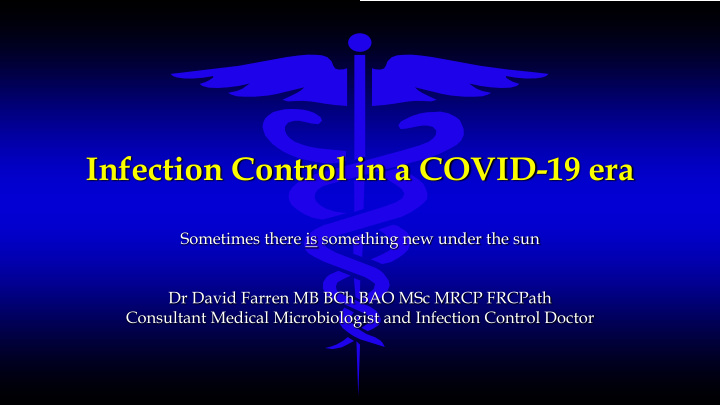



Infection Control in a COVID-19 era Sometimes there is something new under the sun Dr David Farren MB BCh BAO MSc MRCP FRCPath Consultant Medical Microbiologist and Infection Control Doctor
Introduction G SARS-CoV-2 – Member of the coronavirus family – Enveloped RNA virus G Seventh known human pathogen in this family – “Seasonal” coronaviruses – easily spread, not that severe (229E, NL63, OC43, HKU1) – Newer coronaviruses – not so easy to spread, normally very severe (SARS, MERS) – SARS-CoV-2 – very easily spread, can be very severe
Natural progression G Portal of entry – Mucosal surfaces, especially mouth, nose and eyes. Enters cells using the ACE2 enzyme G Incubation period (up to 14 days, mean 5-7) – Virus moves through respiratory tract, starts to multiply up G Viral shedding from respiratory tract – Starts about 2 days before symptoms start, normally until 7 days after symptoms start (14 days if more severe)
Illness G Phase 1 – Normally asymptomatic or very mild symptoms G Phase 2 – Flu-like illness, more common and more severe in elderly – ↓ Lymphs, ↑ AST, ↑ D dimer, ↑ TnT all predictors of progression to… G Phase 3 – Severe pneumonia/ARDS picture, normally leading to ventilation and increased mortality
Spread G Droplets G Indirect contact with droplets (esp. upward facing surfaces) G Aerosols G OF RESPIRATORY SECRETIONS NORMALLY
Testing times G PCR tests (“antigen tests”) – Very rapid and accurate diagnostics – Respiratory secretions normally – Detect RNA in small amounts G Antibody tests – Indicate past infection (at least 14 days post-symptoms) – Detect immune response to SARS-CoV-2 – Accuracy variable
On to the questions…
Recommend
More recommend